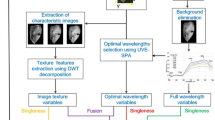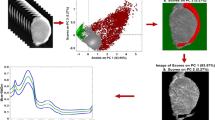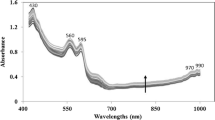Abstract
Glycine, the simplest free amino acid. It is one of the important factors affecting the flavor of beef. In this study, a fast and non-destructive method combining near-infrared hyperspectral (900–1700 nm) and textural data was first proposed to determine the content and distribution of glycine in beef. On the basis of spectral information pre-processing, spectral features were extracted by the interval variable iterative space shrinkage approach, competitive adaptive reweighting algorithm, and uninformative variable elimination (UVE). The glycine content prediction models were established by partial least squares regression, least squares support vector machine, and the optimized shallow full convolutional neural network (SFCN). Among them, the UVE-SFCN model was found to show better results with prediction set determination coefficient (RP2) of 0.8725. Furthermore, textural features were extracted by the gray-level co-occurrence matrix and fused with the spectral information of the best feature band to obtain an optimized UVE-FSCN-fusion model (RP2 = 0.9005, root mean square error = 0.3075, residual predictive deviation = 0.2688). Compared with the full spectrum and characteristic wavelength spectrum models, RP2 was improved by 6.41% and 3.10%. The best fusion model was visualized to represent the distribution of glycine in beef. The results showed that the prediction and visualization of glycine content in beef were feasible and effective, and provided a theoretical basis for the hyperspectral study of meat quality monitoring or the establishment of an online platform.












Similar content being viewed by others
Data Availability
The dataset analyzed during the current study is available from the corresponding author on reasonable request.
References
Alaa EA, Benjamin WB, Holman G (2021) Total volatile basic nitrogen (TVB-N) and its role in meat spoilage: A review. Trends Food Sci Technol 109:280–302. https://doi.org/10.1016/j.tifs.2021.01.006
Bergmann F, Foschum F, Marzel L, Kienle A (2021) Ex Vivo Determination of Broadband Absorption and Effective Scattering Coefficients of Porcine. Tissue 08:31. https://doi.org/10.3390/photonics8090365
Chen YN, Sun DW, Cheng JH, Gao WH (2016) Recent advances for rapid identification of chemical information of muscle foods by hyperspectral imaging analysis. Food Eng Rev 3:336–350. https://doi.org/10.1007/s12393-016-9139-1
Chong SH, Ham S (2014) Site-directed analysis on protein hydrophobicity. J Comput Chem 18:1364–1370. https://doi.org/10.1002/jcc.23631
Christopher T, Liu L, Ngadi M (2022) Improving Intramuscular Fat Assessment in Pork by Synergy Between Spectral and Spatial Features in Hyperspectral Image. Food Anal Methods 15:212–226. https://doi.org/10.1007/s12161-021-02113-1
Cui JR, Li KK, Hao J, Dong FJ, Wang SL, Rodas-González A (2022) Identification of Near Geographical Origin of Wolfberries by a Combination of Hyperspectral Imaging and Multi-Task Residual Fully Convolutional Network. Foods 11:1936. https://doi.org/10.3390/foods11131936
Duan ZL, Dong SL, Dong YW, Gao QF (2021) Geographical origin identification of two salmonid species via flavor compound analysis using headspace-gas chromatography-ion mobility spectrometry combined with electronic nose and tongue. Food Res Int 145:110385. https://doi.org/10.1016/j.foodres.2021.110385
Girmatsion M, Mahmud A (2021) Rapid detection of antibiotic residues in animal products using surface-enhanced Raman Spectroscopy: A review. Food Control 126:108019–108027. https://doi.org/10.1007/978-1-4899-7445-7_7
Golbraikh A (2014) Modelability criteria: statistical characteristics estimating feasibility to build predictive QSAR models for a dataset. Pract Aspects Comput Chem III 23631:187–230. https://doi.org/10.1002/jcc.23631
Jackman P, Sun DW (2008) Prediction of beef eating quality from color, marbling and wavelet texture features. Meat Sci 4:1273–1281. https://doi.org/10.1016/j.meatsci.2008.06.001
Jiang HZ, Hu YL, Jiang XS, Zhou HP (2022) Maturity Stage Discrimination of Camellia oleifera Fruit Using Visible and Near-Infrared Hyperspectral Imaging. Molecules 19:6318. https://doi.org/10.3390/molecules27196318
Kehchiromuramatsu H (1971) Effect of excess levels of individual amino acids on growth of rats fed casein diets. Lab Food Nutr 10:1117–1125. https://doi.org/10.1093/jn/101.9.1117
Kobayashi KI, Matsui Y, Maebuchi Y, Toyota T, Nakauchi S (2010) Near infrared spectroscopy and hyperspectral imaging for prediction and visualisation of fat and fatty acid content in intact raw beef cuts. J near Infrared Spectrosc 18:301. https://doi.org/10.1255/jnirs.896
Kucha CT, Liu L (2018) Non-destructive spectroscopic techniques and multivariate analysis for assessment fat quality in pork and pork products: a review. J Sensors 2:377. https://doi.org/10.3390/s18020377
Li WY (2015) Simultaneous quantification of uronic acid, amino sugar, and neutral sugar in the acidic polysaccharides extracted from the roots of angelica sinensis (Oliv) diels by HPLC. Food Anal Methods 8:2087–2093. https://doi.org/10.1007/s12161-015-0096-8
Li J, Zhang H, Zhan B et al (2019) Nondestructive firmness measurement of the multiple cultivars of pears by Vis-NIR spectroscopy coupled with multivariate calibration analysis and MC-UVE-SPA method. Infrared Phys Technol 104:103154. https://doi.org/10.1016/j.infrared.2019.103154
Liem-Moolenaar M, Zoethout R (2010) The effects of a glycine reuptake inhibitor R231857 on the central nervous system and on scopolamine-induced impairments in cognitive and psychomotor function in healthy subjects. J Psychopharmacol 11:1681–1687. https://doi.org/10.1177/0269881109105573
Liu H, Ji Z, Liu X, Shi C, Yang X (2020) Non-destructive determination of chemical and microbial spoilage indicators of beef for freshness evaluation using front-face synchronous fluorescence spectroscopy. Food Chem 1:0308–8146. https://doi.org/10.1016/j.foodchem.2020;321(1):0308-8146
Liu CC, Chu ZJ, Weng SZ, Zhu GQ, Han KX, Zhang ZX et al (2022) Fusion of electronic nose and hyperspectral imaging for mutton freshness detection using input-modified convolution neural network. Food Chem 385:132651. https://doi.org/10.1016/j.foodchem.2022.132651
Morikawa K, Igarashi T, Misumi S, Fukuda T, Ojiri H, Matsudaira H et al (2019) A case of pseudocystic liver metastases from an atypical lung carcinoid tumor. Radiol Case Rep 5:595–601. https://doi.org/10.1016/j.radcr.2019.02.022
Nassar L, Okwuchi IE, Saad M, Karray F, Agrawal P (2020) Prediction of strawberry yield and farm price utilizing deep learning. Int Joint Conf Neural Netw 2020. https://doi.org/10.1109/IJCNN48605.2020.9206998
Nolasco Perez IM, Badaró AT, Barbon S, Barbon APAC, Pollonio MAR, Barbin DF (2018) 使用便携式近红外(NIR)分光光度计和机器学习对鸡肉部分进行分类。应用光谱学 12:1774–80. https://doi.org/10.1177/0003702818788878
Pratima A, Fernanda C, Guanchen L, Woo K (2022) Effects of Total Sulfur Amino Acids on Growth Performance, Immunity, and Meat Yield in Broilers Fed Diets With and Without Antibiotics. Front Vet Sci 6:02. https://doi.org/10.3389/fvets.2022.903901
Wan QM, Ouyang AG, Liu YD, Xiong ZY, Li X, Li LS (2022) Detection of infestation by striped stem-borer (Chilo suppressalis) in rice based on hyperspectral imaging. J Food Process Eng 08:07. https://doi.org/10.1111/jfpe.14142
Wang CX, Wang SL (2020) Combination of spectra and texture data of hyperspectral imaging for prediction and visualization of palmitic acid and oleic acid contents in lamb meat. Meat Sci 169:108194. https://doi.org/10.1016/j.meatsci.2020.108194
Weng S, Guo B, Tang P, Yin X, Pan F, Zhao Z (2020) Rapid detection of adulteration of minced beef using Vis/NIR reflectance spectroscopy with multivariate methods. Spectrochim Acta A Mol Biomol Spectrosc 230:118005. https://doi.org/10.1016/j.saa.2019.118005
Weng SZ, Guo BQ, Du YH, Wang MQ, Tang PP, Zhao JL (2021) Feasibility of Authenticating Mutton Geographical Origin and Breed Via Hyperspectral Imaging with Effective Variables of Multiple Features. Food Anal Methods 14:834–844. https://doi.org/10.1007/s12161-020-01940-y
Xu M, Sun J, Yao KS, Cai Q, Shen JF, Tian Y, Zhou X (2021) Developing deep learning based regression approaches for prediction of firmness and pH in Kyoho grape using Vis/NIR hyperspectral imaging. Infrared Phys Technol 120:104003. https://doi.org/10.1016/j.infrared.2021.104003
Yda B, As A, Crcb C, Mmra B (2020) A global calibration model for prediction of intramuscular fat and pH in red meat using hyperspectral imaging ScienceDirect. Meat Sci 181:108405. https://doi.org/10.1016/j.meatsci.2020.108405
Zhang DY, Chen G, Yin X, Hu RJ, Gu CY, Pan ZG et al (2020) Integrating spectral and image data to detect Fusarium head blight of wheat. Comput Electron Agric 175:105588. https://doi.org/10.1016/j.compag.2020.105588
Zou JJ, Chang BK, Zhang Y, Yang Z (2010) Variation of spectral response from cesium-covered. East China Inst Technol 14:2561–2565. https://doi.org/10.1016/j.foodres.2011.05.001
Funding
This work was supported by the Ningxia Hui Autonomous Region fund (2022AAC05022) and Key R & D plan of the Autonomous Region (2019BEH03002).
Author information
Authors and Affiliations
Contributions
All authors contributed to the study conception and design. Material preparation were performed by Yu Lv, Fujia Dong, and Sijia Liu. Data collection and analysis were performed by Yu Lv and Fujia Dong. The first draft of the manuscript was written by Yu Lv, and all authors commented on previous versions of the manuscript. All authors read and approved the final manuscript.
Yu Lv: Writing, original draft; writing, review and editing; conceptualization; formal analysis; investigation.
Fujia Dong: Data curation, formal analysis, investigation.
Jiarui Cui: Data curation, Formal analysis, methodology, software.
Jie Hao: Investigation, visualization, writing—review and editing.
Ruiming Luo: Funding acquisition, resources.
Songlei Wang: Funding acquisition, project administration, resources.
Argenis Rodas-Gonzalez: Supervision.
Sijia Liu: Validation, visualization, writing—review and editing.
Corresponding author
Ethics declarations
Competing interests
The authors declare no competing interests.
Ethics Approval
This article does not contain any studies with human participants or animals performed by any of the authors.
Conflict of Interest
Yu Lv declares that he has no conflict of interest. Fujia Dong declares that he has no conflict of interest. Jiarui Cui declares that he has no conflict of interest. Jie Hao declares that he has no conflict of interest. Ruiming Luo declares that he has no conflict of interest. Songlei Wang declares that he has no conflict of interest. Argenis Rodas-Gonzalez declares that he has no conflict of interest. Sijia Liu declares that he has no conflict of interest.
Informed Consent
Informed consent is not applicable.
Additional information
Publisher's Note
Springer Nature remains neutral with regard to jurisdictional claims in published maps and institutional affiliations.
Rights and permissions
Springer Nature or its licensor (e.g. a society or other partner) holds exclusive rights to this article under a publishing agreement with the author(s) or other rightsholder(s); author self-archiving of the accepted manuscript version of this article is solely governed by the terms of such publishing agreement and applicable law.
About this article
Cite this article
Lv, Y., Dong, F., Cui, J. et al. Fusion of Spectral and Textural Data of Hyperspectral Imaging for Glycine Content Prediction in Beef Using SFCN Algorithms. Food Anal. Methods 16, 413–425 (2023). https://doi.org/10.1007/s12161-022-02425-w
Received:
Accepted:
Published:
Issue Date:
DOI: https://doi.org/10.1007/s12161-022-02425-w




